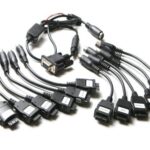For automotive enthusiasts and professional mechanics alike, understanding a vehicle’s performance and health is paramount. Modern vehicles are complex machines, relying heavily on their onboard computer systems. Fortunately, accessing and interpreting this data has become remarkably accessible thanks to Performance Tool Obdii/eobd. These tools are game-changers, offering insights into your car’s inner workings and empowering you to optimize its performance.
Decoding OBDII and EOBD: The Basics
OBDII (On-Board Diagnostics II) and EOBD (European On-Board Diagnostics) are standardized systems that provide access to a vehicle’s self-diagnostic and reporting capabilities. Mandated in the United States in 1996 (OBDII) and in Europe in 2001 for gasoline vehicles and 2004 for diesel vehicles (EOBD), these systems monitor various engine and emission control parameters. This standardization is crucial, as it means a single tool can communicate with a wide range of vehicles across different manufacturers.
Performance OBDII/EOBD tools leverage this standardized access to go beyond basic diagnostics. They are designed to provide deeper insights into vehicle performance, allowing users to:
- Read and Clear Diagnostic Trouble Codes (DTCs): Identify the source of check engine lights and other warning indicators.
- Monitor Live Data Streams: Observe real-time parameters like engine speed (RPM), coolant temperature, oxygen sensor readings, and fuel trim.
- Perform Advanced Diagnostics: Access more in-depth system information and run specific tests.
- Enhance Vehicle Performance: In some cases, these tools can be used to adjust certain vehicle parameters for improved performance or fuel efficiency (depending on the tool’s capabilities and vehicle compatibility).
Alt text: Locating the OBDII port in your vehicle, typically found under the dashboard on the driver’s side, for easy access with performance diagnostic tools.
Why Choose a Performance OBDII/EOBD Tool?
While basic OBDII scanners are readily available, performance-oriented tools offer significant advantages for those seeking more than just error code reading. Here’s why investing in a performance tool is a worthwhile decision:
Enhanced Diagnostic Capabilities
Performance tools often provide more detailed diagnostic information compared to basic scanners. They can access a wider range of parameters, offer advanced testing features, and present data in a more user-friendly format, such as graphs and charts. This deeper level of insight is invaluable for accurately diagnosing complex issues and understanding the root cause of performance problems.
Real-time Performance Monitoring
One of the key benefits of performance OBDII/EOBD tools is their ability to monitor live data streams. This real-time data allows you to observe how your vehicle is performing under various conditions. Whether you’re tracking engine temperature during spirited driving, monitoring fuel efficiency on a long trip, or analyzing sensor readings for optimal performance, live data provides crucial feedback.
Performance Optimization Potential
Certain advanced performance tools go beyond diagnostics and offer features for performance optimization. These tools may allow you to:
- Tune Engine Parameters: Adjust air-fuel ratios, ignition timing, and other settings (with caution and proper knowledge).
- Monitor and Improve Fuel Efficiency: Analyze fuel consumption data and identify areas for improvement.
- Track Performance Metrics: Measure acceleration times, horsepower, and other performance indicators.
It is crucial to note: Modifying vehicle parameters should only be undertaken with a thorough understanding of engine management systems and the potential consequences. Incorrect adjustments can negatively impact performance, fuel economy, and even engine reliability.
Alt text: A performance OBDII/EOBD tool showcasing live engine data parameters on its screen, essential for real-time vehicle monitoring and diagnostics.
Selecting the Right Performance Tool
The market offers a wide array of performance OBDII/EOBD tools, ranging from handheld scanners to smartphone-based systems. Choosing the right tool depends on your needs and budget. Consider the following factors:
- Features and Functionality: Determine the features you require. Do you need advanced diagnostics, live data streaming, performance tuning capabilities, or specific manufacturer coverage?
- Ease of Use: Look for a tool with an intuitive interface and clear instructions, especially if you are new to OBDII diagnostics.
- Compatibility: Ensure the tool is compatible with your vehicle’s make, model, and year.
- Budget: Performance tools range in price from entry-level options to professional-grade systems. Set a budget and choose a tool that offers the best value for your needs.
- Reviews and Reputation: Read reviews and consider the reputation of the manufacturer to ensure you are investing in a reliable and high-quality tool.
Conclusion: Empower Your Automotive Experience
Performance OBDII/EOBD tools are powerful assets for anyone seeking to understand, maintain, and optimize their vehicle’s performance. Whether you are a seasoned mechanic or a passionate car owner, these tools provide invaluable insights into your vehicle’s health and capabilities. By choosing the right performance tool and utilizing its features effectively, you can unlock a new level of automotive understanding and control, ensuring your vehicle runs at its best for years to come. Investing in a quality performance OBDII/EOBD tool is an investment in your vehicle’s longevity and your driving enjoyment.
Disclaimer: Always consult your vehicle’s service manual and follow the tool manufacturer’s instructions carefully. Improper use of performance OBDII/EOBD tools can potentially damage your vehicle or void warranties. Seek professional advice when necessary.

